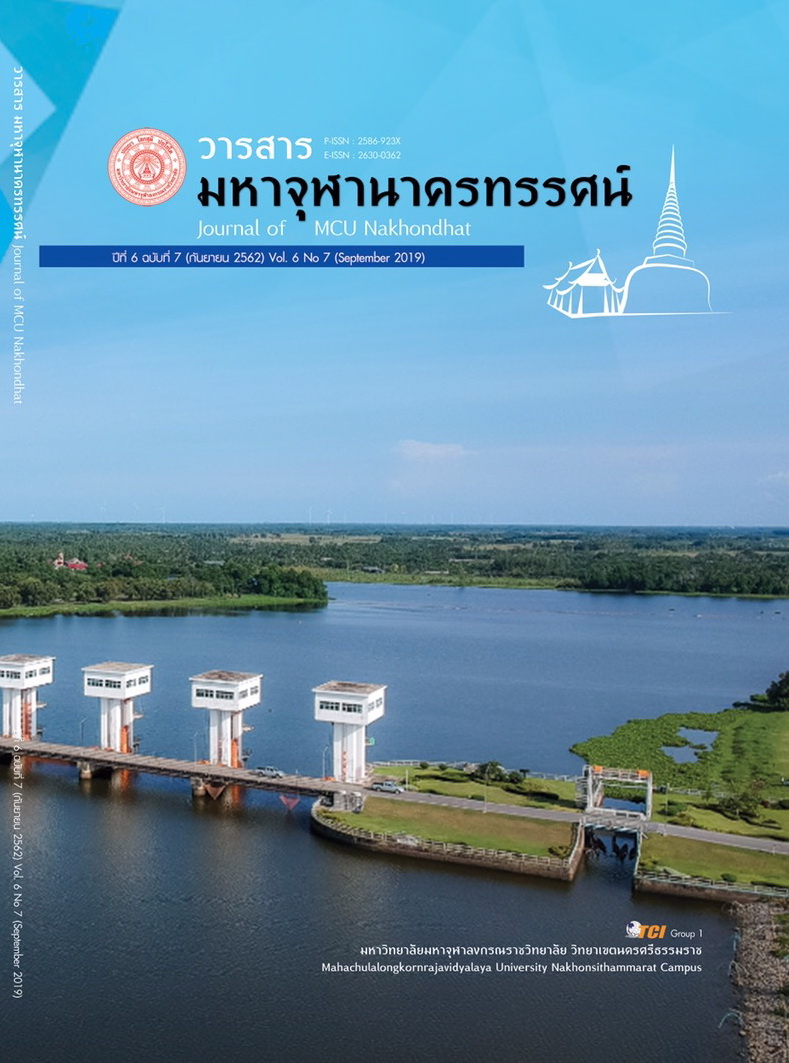THE PROCESS OF THE BUDDHIST HARMONY CREATION IN BAN CHETAWAN (NONGMOO), MUAENG DISTICT, LAMPHUN PROVINCE
Main Article Content
Abstract
The objectives of this research were: 1) to study the problems and factors of the lack of unity at Ban Chetawan (Nong Moo), 2) to study the process of creating harmony of Ban Chetawan (Nong Moo) and, 3) to analyze and synthesize the process of harmonious creation in Buddhism of Ban Chetawan (Nong Moo). This is documentary research and qualitative research.
The results of the research provided that:
1. The problems of the lack of unity at Ban Chetawan (Nong Moo) were a lack of visionary leadership, the lack of principles and no aims for the village, the lack of planning and no projects, no teamwork and evaluation of systematic reviews. The main factors that cause non-harmony in the village were nobody dedicates oneself to social activities, no humility to each other and no consideration for others.
2. The process of creating harmony was the village leader should be elected by the members of the village, therefore have a good leadership skill with knowledge, virtue, and ability as a set plan. Moreover, be on the plan of the village such as having projects, set up teamwork, and having the systematic evaluation. Consequently, the members of the village would have harmony and support each other in a team as the Buddhist Principle of Harmonious living; for example, Saraniyadhamma, Sangahavatthudhamm, and Aparihaniyadhamma.
3. The analysis and synthesis of the process of harmonious creation in Buddhism of Ban Chetawan (Nong Moo) should have 1) a good leader 2) ideology 3) objective plan 4) good teamwork 5) evaluation of systematic reviews
Article Details
References
เทศบาลตำบลอุโมงค์ จังหวัดลำพูน. (2561). ข้อมูลชุมชนเทศบาลตำบลอุโมงค์. ลำพูน: สำนักงานเทศบาลตำบลอุโมงค์ จังหวัดลำพูน.
ธรรมนูญ เพ็งทอง. (2549). วิวัฒนาการและโครงสร้างเกี่ยวกับสังคม. เรียกใช้เมื่อ 24 กรกฏาคม 2561 จากhttps://www.moe.go.th/moe/th/news/detail.php?NewsID=9511&Key =news_research
นวพร ปัญญากรสกุล. (2555). การสร้างความสามัคคีในหมู่บ้านต้นแบบเศรษฐกิจพอเพียงจังหวัดเชียงใหม่. ใน ดุษฎีนิพนธ์พุทธศาสตรดุษฎีบัณฑิต สาขาวิชาพระพุทธศาสนา. มหาวิทยาลัยมหาจุฬาลงกรณราชวิทยลัย.
พระครูนิกรสุนทรกิจ (สมพงษ์ นุ่มสกุล). (2553). ศึกษาวิเคราะห์เรื่องความสามัคคีในคัมภีร์พระพุทธศาสนาเถรวาท. ใน วิทยานิพนธ์พุทธศาสตรมหาบัณฑิต สาขาวิชาพระพุทธศาสนา. มหาวิทยาลัยมหาจุฬาลงกรณราชวิทยาลัย.
พระครูศรีปริยัติคุณาภรณ์. (2560). การประยุกต์ใช้หลักสาราณียธรรมเพื่อสร้างความปรองดองสมานฉันท์ของประชาชน จังหวัดอุดรธานี สกลนคร หนองคาย และกาฬสินธุ์. วารสารสถาบันวิจัยญาณสังวร, 8(1), 66-78.
พระบุญเรือง จิตธมฺโม (สุทธิชัย). (2549). การศึกษาเชิงวิเคราะห์ภาวะผู้นำในพระพุทธศาสนา :ศึกษาเฉพาะกรณีวิธีแก้ปัญหาของพระพุทธเจ้า. นครปฐม: มหาวิทยาลัยมหามกุฏราชวิทยาลัย.
มหาจุฬาลงกรณราชวิทยาลัย. (2539). พระไตรปิฎกภาษาไทย ฉบับมหาจุฬาลงกรณราชวิทยาลัย. กรุงเทพมหานคร: โรงพิมพ์มหาจุฬาลงกรณราชวิทยาลัย.
วิศุทธิ์ ขวัญพฤกษ์. (2539). การศึกษาหลักธรรมของพระพุทธศาสนาที่สามารถนำมาปรับใช้กับการบริหารงานบุคคลในองค์กรธุรกิจ”,. ใน วิทยานิพนธ์บริหารธุรกิจมหาบัณฑิต สาขาวิชาการบริหารธุรกิจ. มหาวิทยาลัยเชียงใหม่.
สำนักงานคณะกรรมการพัฒนาเศรษฐกิจและสังคมแห่งชาติ. (2560). แผนพัฒนาเศรษฐกิจและสังคมแห่งชาติ ฉบับที่ 12 (พ.ศ. 2560- 2564). กรุงเทพมหานคร: สำนักงานคณะกรรมการพัฒนาเศรษฐกิจและสังคมแห่งชาติ .


